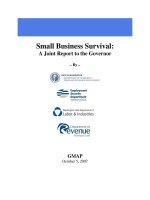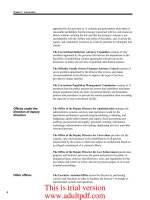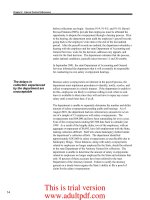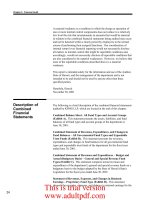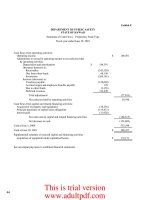Small Business Survival: A Joint Report to the Governor pot
Bạn đang xem bản rút gọn của tài liệu. Xem và tải ngay bản đầy đủ của tài liệu tại đây (269.67 KB, 38 trang )
Small Business Survival:
A Joint Report to the Governor
– By –
GMAP
October 5, 2007
Acknowledgements
Study Coordinators
Vikki Smith, Department of Revenue
Mary Welsh, Department of Revenue
Business Survival Study Work Group
Cyndee Baugh, Department of Community Trade and Economic Development
Jim Keogh, Department of Community Trade and Economic Development
Gary Bodeutsch, Employment Security Department
Greg Weeks, Employment Security Department
Ron Langley, Department of Labor and Industries
Ronald Moore, Department of Labor and Industries
Richard Bredeson, Department of Labor and Industries
Lorrie Brown, Department of Revenue
Mike Gowrylow, Department of Revenue
Deborah Stephens, State Board for Community and Technical Colleges
Study Group Advisors
Bruce Botka, Office of the Governor
Leslie Cushman, Department of Revenue
Patricia Delaney, Department of Labor and Industries
Irv Lefberg, Office of Financial Management
Paul Trause, Employment Security Department
This report is available on the GMAP website: www.accountability.wa.gov
Small Business Survival:
A Joint Report by the Departments of Community, Trade and Economic
Development, Employment Security, Labor and Industries, and Revenue
EXECUTIVE SUMMARY
Introduction
This report stems from discussions at the Governor’s December 1, 2006, Economic Vitality
Government, Management, Accountability and Performance (GMAP) forum, in which the
Governor charged the Departments of Labor and Industries (L&I), Employment Security (ESD),
Revenue (DOR), and Community, Trade and Economic Development (CTED) to work together
to determine what government can do to increase small business success.
This report concludes that there are four major areas where state government can effectively
improve the odds for small business survival and success. Government can:
• Coordinate and partner to support business planning and training,
• Support a competitive regulatory environment,
• Provide communication and outreach with small businesses, and
• Facilitate efforts to provide infrastructure and assist in small business financing.
The four agencies were charged in the course of their analysis to examine statistics showing that
Washington has among the nation’s highest rates of business start-ups and closures. The
Governor’s leadership team also asked the agencies to develop common definitions to provide a
consistent framework for data collection, analysis, and research.
Study Question and Objectives
Representatives of the four agencies and the Governor’s GMAP office formed a work group,
coordinated by the Department of Revenue, to analyze the following research question: What
does research tell us about what state government can effectively do to increase new business
success during their first three years of operation?
October 5, 2007 Page 4
The objectives of the study were to determine:
y Whether Washington’s relatively high level of “business churn” – large numbers of
business start-ups and closures – is good, bad, or a neutral factor for the state’s economy;
y What causes businesses to fail;
y What role government may have in business failure; and
y What government can do to help promote business survival and success.
As directed by the Governor, the agencies participating in the work group agreed on a common
definition of the types of businesses on which the study would focus: firms with $3 million or
less in annual revenue and firms with either no employees or 20 or fewer employees.
Background
Washington State is recognized as having a strong and innovative economy and a positive
business climate. The state is on track to create 250,000 net new jobs between January 2005 and
December 2008. Forbes magazine recently reported that Washington has the fifth best business
climate in the U.S. Washington was ranked in the top five for the quality of its labor force,
including educational attainment; the state’s regulatory environment; and projected economic
growth.
Governor Gregoire, her cabinet agencies, and the Legislature have taken a number of steps to
strengthen the efforts of state government to help businesses and improve the state’s economic
vitality. The state’s economic development goals and strategies are described in detail in The
Next Washington report issued by the Governor earlier this year. One of the key elements of The
Next Washington agenda is support for small business. The report specifically states that “we
need to take additional steps to make government accessible and effective for small business."
In line with this goal, the Governor’s Office of Regulatory Assistance (ORA) joined with DOR,
ESD, and L&I to conduct a series of business roundtables across Washington State to identify
opportunities to expand efforts to reduce Washington’s regulatory requirements. This report
supplements information generated during the roundtables, and its conclusions strongly support
the activities planned by ORA during the coming months.
Sources of Data and Information
In addition to data and information provided by the participating agencies, sources used in this
report include:
y Interviews with organizations that provide assistance to small businesses in their local
communities, such as Small Business Development Centers (SBDCs), the U.S. Small
Business Administration (SBA), and an Eastern Washington bank vice president. The
interviewees represent organizations that have firsthand knowledge of thousands of start-
October 5, 2007 Page 5
up businesses. A list of business experts interviewed for this report is in the bibliography
(see Appendix 2);
y A survey of participants at the “Open for Business” roundtables. The survey was
sponsored by ORA and DOR, ESD, and L&I;
y Academic literature on business survival; and
y National rankings of the 50 states on business starts and closures and their business
climates.
Findings
y About 93 percent of the businesses that register to pay taxes in Washington meet the
definition of a small business used in this report: these firms employ 20 or fewer workers
or are solely operated by the owner and earn $3 million or less in annual gross income.
y Small business formation is higher in years marked by slow economic growth.
y Research revealed different perspectives on “business churn.” The work group
concluded that the phenomenon of Washington’s large numbers of start-ups and closures
is generally beneficial for the economy as a whole, but this view must be tempered with
the understanding that individual business closures often cause significant personal and
family difficulties. Overall, business churn appears to be a natural outgrowth of a vibrant
economy marked by high levels of innovation and risk-taking.
y Small rural businesses form a larger part of Washington’s rural economy than do their
urban counterparts. On average, the gross income generated by small rural businesses
represents a larger portion of their county’s economy and is more stable over economic
cycles than that of small urban firms.
y Business failures have many causes, relatively few of which could be prevented with
government assistance. Key causes include inadequate financing and planning, overly
optimistic assumptions, noncompetitive pricing, and inadequate marketing.
y Washington businesses pay a higher initial share of taxes than individuals compared to
other states. However, overall tax burdens on both households and businesses are very
low compared to other states – Washington ranks 37
th
from the highest in taxes as a share
of personal income. The three regulatory agencies have acted to relieve the burden on
small businesses. In 2007 legislation, ESD reduced taxes on start-up businesses. L&I
has reduced workers’ compensation premiums for the second half of 2007. DOR
provides a small business credit that eliminates or gives partial B&O tax relief to over
175,000 taxpayers. Nevertheless, taxes can be a significant burden for new small
businesses, especially if business owners do not carefully plan for these expenses.
Government can help businesses survive by providing support for: (1) business planning and
training, (2) a competitive regulatory environment, (3) communication and outreach with small
businesses, and (4) infrastructure and assistance in small business financing.
October 5, 2007 Page 6
JOINT AGENCY REPORT ON SMALL BUSINESS SURVIVAL
Profile of Washington Small Businesses and Start-Ups
Study Question and Objectives
This report stems from discussion at the Governor’s December 1, 2006, Economic Vitality
Government, Management, Accountability and Performance (GMAP) forum, in which she
charged the departments of Labor and Industries (L&I), Employment Security (ESD), Revenue
(DOR), and Community, Trade and Economic Development (CTED) to work together to
determine what government can do to increase small business success.
Representatives of the four agencies and the Governor’s GMAP office formed a work group,
coordinated by the Department of Revenue, to analyze the following research question: What
does research tell us about what state government can effectively do to increase new business
success during their first three years of operation?
The objectives of the study were to determine:
y Whether Washington’s relatively high level of “business churn” – large numbers of
business start-ups and closures – is good, bad, or a neutral factor for the state’s economy;
y What causes businesses to fail;
y What role government may have in business failure; and
y What government can do to help promote business survival and success.
Sources of Data and Information
The work group saw its task as pulling together disparate sources of information to inform its
analysis. There are numerous academic studies of small businesses that attempt to determine
factors that influence their growth and survival. There are small business owners with specific
experience of conducting business in Washington and business experts who consult with
thousands of small local businesses. The agencies maintain records of their tax and rate payers
that yield information on size, location, industry, and business owner type. Information sources
included:
y Interviews with organizations that provide assistance to small businesses in their local
communities, such as Small Business Development Centers (SBDCs), the U.S. Small
October 5, 2007 Page 7
Business Administration (SBA), and an Eastern Washington bank vice president. The
interviewees represent organizations that have firsthand knowledge of thousands of start-
up businesses. A list of business experts interviewed for this report is in the bibliography
(see Appendix 2);
y A survey of participants at the “Open for Business” roundtables. The survey was
sponsored by the Governor’s Office of Regulatory Assistance (ORA) and DOR, ESD,
and L&I;
y Academic literature on business survival; and
y National rankings of the 50 states on business starts and closures and their business
climates.
Definition of Small Business
For the purposes of this report, small business is defined both in terms of employment and gross
income. A small business: (1) employs 20 or fewer employees or is a nonemployer, and
(2) reports gross income of $3 million or less.
For the purpose of controlling who is in and who is out of the data, this definition comes closest
to excluding multistate firms who have few employees in state but have high Washington gross
income or large employers with relatively small gross income such as school districts.
This definition includes 93 percent of all Washington firms and 19.4 percent of the Washington
private sector workforce. Gross income of firms falling under this definition represents 17
percent of all Washington business income.
Definition of Start-up Firms
A newly registered entity is considered to be a "start-up" firm if it reports gross income to DOR
in the year it registers and is counted as a closure when it ceases to report income. In this report,
firm survival means the firm continues to report income after its third year in operation. This
definition does count as a closure for those firms that cease operation because of a potentially
successful outcome such as a merger or acquisition – about 20 percent of employers that close
their accounts have transferred their employees to another business (ESD, Employer Turnover
Study, 2006). Despite the inclusion of such firms in the data, the work group believes the
findings in the report are reasonable because they are supported by the other evidence.
It is important to note that close to half of all registrants never report gross income to DOR,
either because they never earn income or because their income is below the reporting threshold
of $28,000 in annual gross income.
Most start-up firms are small. Of the approximately 80,000 to 90,000 new firms that register
with DOR each year, 98 percent meet this report’s definition of small business. A small business
typically begins as a sole proprietor which is a solely-owned business with few if any employees.
As a sole proprietor expands, the owner may form a limited liability company (LLC) to gain
October 5, 2007 Page 8
protection from debts of the business and to include a limited number of member owners or
partners.
0
10,000
20,000
30,000
40,000
50,000
1982 1984 1986 1988 1990 1992 1994 1996 1998 2000 2002 2004 2006
Number of Firms
Sole Proprietors
Limited Liability
Companies
Corporations
Employment
Slowdown
Sole proprietors, the most common form of new business, tend to form during economic downturns. LLCs are now
the fastest growing form of new business.
Source: Department of Revenue, Business Registration Management System, registrations calendar 1982 through 2006
In general, sole proprietorships have been the most prevalent form of business ownership.
Likewise, they are the most common form of new business, making up over half of all new DOR
registrants. The number of sole proprietors that registered with DOR grew dramatically over the
last 15 years from 20,000 in 1982 to almost 50,000 in 2006. LLCs have grown rapidly to 20,000
firms since passage of limited liability laws in Washington in 1994.
Sole proprietor formation is higher in years with slow economic growth. This may be because
many laid-off employees start small businesses. Often these businesses close when the owner
becomes employed again. Note that the number of sole proprietors increases dramatically as the
business cycle declines but that the number of corporations and LLCs does not appear to be
impacted by the economy.
October 5, 2007 Page 9
Looking at types of industries, service firms form the highest percentage of new firms at 30
percent of the total. Examples of typical new service firms include professional services such as
law offices, bookkeepers, and architects; business services such as management consultants; and
personal services such as beauty shops and interior decorators. Retail trade and construction
industries claim the next highest percentages of new small firms. Together, these three sectors –
services, retail and construction – make up two-thirds of all new small firms.
Percentage of New Registrants by Industry
Retail Trade
22%
Construction
14%
Services
30%
Information
2%
Finance, Insurance,
Real Estate
5%
Accommodation & Food
Services
5%
Trans, Warehousing,
Util
3%
Manufacturing
3%
Wholesale Trade
4%
Other
12%
1
Source: Department of Revenue, Business Registration Management System, new registrations 2005
Business churn – is it good for the economy?
In general, the literature reviewed by the work group concludes that business churn is beneficial
for the economy and tends to sort out inefficient businesses (Everett and Watson, SBA
The Small
Business Economy: Report to the President, Biolink Newsletter, Kauffman Foundation). New
businesses are considered necessary to turn innovations into useful products and services.
Generally, the literature suggests that the number of business closures corresponds directly with
the number of business start-ups and are, therefore, a consequence of innovation.
Some studies represent a different perspective on churn. The failure of a business may mean the
loss of some innovative and useful technology that will not be developed as a result (SBA, The
Small Business Economy: Report to the President). Higher rates of business failure discourage
business start-ups (SBA, The Small Business Economy: Report to the President). Business
experts interviewed by the work group see some business closures as personal tragedies – owners
October 5, 2007 Page 10
that lose their businesses often lose their life savings and may experience other personal
problems as a result.
Survival Rates
On average about 65 percent of all new small businesses survive their first three years in
business. Firms that did not report gross income in their first year are excluded from the data.
Survival rates vary by a number of factors:
• Business owner type,
• Industry, and
• Urban and rural location.
The statistics indicate that corporations, LLCs, and partnerships are far more likely to survive
than sole proprietors. Half of sole proprietors survived their first three years in business and, by
the end of five years, only one-third continued to report gross income.
70%
50%
100%
100%
80%
67%
0%
20%
40%
60%
80%
100%
Reported Income in Year 1
Year 2 Year 3
Continued to report income
Sole Proprietors Corps, LLCs, Partnerships
13,505 14,206
9,500
6,799
11,398
9,572
Sole proprietors are less likely to survive their first few years than other firms.
Source: Department of Revenue, excise tax data 2002 through 2005
October 5, 2007 Page 11
Rural counties that are not near major highways exhibit the highest rate of survival. Over 70
percent of firms in these remote counties survive at least three years compared to the statewide
average of 65 percent. The work group concluded that in the case of these remote counties,
business survival indicates a slack economy rather than a strong economy. Large employers tend
to locate in urban areas close to population centers with a growing customer and employment
base. Businesses in remote counties serve a more stable population with less competition from
the outside.
Klickitat
Ferry Stevens
Pend
Oreille
Lincoln S
p
okane
Adams
Whitman
Okanogan
Whatcom
Chelan
Snohomish
King
San
Juan
Island
Douglas
Grant
Clark
Yakima
Lewis
Skamania
Cowlitz
Wahkiakum
Pacific
Grays
Harbor
Thurston
Pierce
Kittitas
Benton
Walla Walla
Franklin
Columbia
Garfield
A
sotin
Jefferson
Clallam
Kitsap
Mason
Skagit
Over 70% survival
65% to 70% survival
Less than 65% survival
The remote rural counties experience higher rates of survival due to the small number of firms, the
lack of opportunity, and the lack of competition
.
Source: Department of Revenue and Employment Security, excise tax and employment data 2002 through 2005
October 5, 2007 Page 12
Survival varies by type of industry. Health care services and wholesale trade survive at higher
rates than the average, while restaurant and accommodation, construction, and retail trade
survival rates are lower than average.
Health care and wholesale trade have the highest survival rates among small businesses.
Restaurants, construction, and retail have the lowest survival rates.
61%
64%
62%
77%
69%
66%
63%
71%
0%
10%
20%
30%
40%
50%
60%
70%
80%
A
ccommodation
& Food Services
A
dmin/Support,
Waste Mgt
Construction Health Care &
Social
A
ssistance
Manufacturing Professional,
Tech, Mgt
Services
Retail Trade Wholesale
Trade
Average
65%
Source: Department of Revenue and Employment Security, excise tax and employment data 2002 through 2005
October 5, 2007 Page 13
Small Businesses and the Rural Economy
Small firms form a larger part of Washington's rural economy than their urban counterparts.
There are relatively few employment opportunities in rural areas. Local businesses, rather than
chains and franchises, tend to meet the service needs of residents. This is a national pattern as
well, according to the literature.
61%
54%
51%
48%
47%
46%
45%
43%
42%
42%
41%
39%
36%
35%
35%
33%
32%
32%
30%
29%
28%
28%
26%
26%
25%
24%
22%
22%
21%
20%
19%
19%
19%
19%
17%
15%
15%
15%
13%
0% 10% 20% 30% 40% 50% 60%
70%
SAN JUAN
WAHKIAKUM
COLUMBIA
ISLAND
PACIFIC
JEFFERSON
DOUGLAS
CLALLAM
FERRY
OKANOGAN
LINCOLN
KITTITAS
A
DAMS
KITSAP
STEVENS
WALLA WALL
A
GARFIELD
A
SOTIN
THURSTON
GRANT
FRANKLIN
SKAGIT
KLICKITAT
CHELAN
SNOHOMISH
CLARK
BENTON
WHATCOM
YAKIMA
PIERCE
GRAYS HARBOR
SPOKANE
WHITMAN
MASON
SKAMANIA
LEWIS
PEND OREILLE
KING
COWLITZ
A
verage income share represented by small businesses = 19%
Defined as a rural county in statute
Small firms are more critical to the rural economy than they are to the urban economy.
Small business gross income as a
percentage of total county business
income
Source: Department of Revenue and Employment Security, excise tax and employment data, 2005
October 5, 2007 Page 14
The average income of small businesses is stable and growing in rural areas of Washington State.
In urban areas the average income fluctuates more with the business cycle.
$400,000
$500,000
$600,000
$700,000
$800,000
$900,000
$1,000,000
$1,100,000
$1,200,000
1990 1991 1992 1993 1994 1995 1996 1997 1998 1999 2000 2001 2002 2003 2004 2005
The average income of rural firms is stable and growing, while the average income of urban firms
fluctuates with the economy.
Urban Counties
Rural Counties
Employment Slowdown
Source: Department of Revenue, excise tax data 1990 through 2005
Washington’s Rankings of Business Start-ups and Closures
It is generally accepted that Washington has among the highest rates of business churn in the
nation. The SBA has developed a widely-published rank of states in order of start-ups and
closures and consistently places Washington in the top ten states for both. Estimates from the
U.S. Census Bureau and the Bureau of Labor Statistics are the source of these rankings based on
data received from each state. However, the SBA rankings and other rankings of start-ups and
closures should be viewed with caution. In these rankings, states make no distinction between
businesses that close because the owner retires, the business changes ownership, or is bought out
by another firm. States also include private household employers in their data. The number and
closure rates for these vary considerably from state to state.
Despite these issues with the data, it appears that the statistics are sufficient to conclude that
Washington has a high rate of firm start-ups and closures. Our high rate of start-ups and closures
does not appear to affect the business and entrepreneurial climate rankings that place
Washington very high in rank (see Appendix 3).
October 5, 2007 Page 15
What are the main causes of business failure?
The following list summarizes causes from the literature and interviews of business experts
conducted by the work group. The main causes for small business failure are identified as
limited experience and limited knowledge of how to run a business.
• Failure to plan appropriately
• Overly optimistic business owners
• Inadequate marketing
• Primary focus on product or service, not on acquiring capital, accounting, and hiring
• Employee theft and other problems of new hires
• Pricing not sufficient to cover overhead costs
• Undercapitalization
• High cost of health care for business owners and employees
(Articles from sources such as Peake and Marshall, Young and Wu, Mason, Goetz, Atherton,
Hellman and Puri, The SmallBiz Guide, Captureplanning.com and interviews support this list.
See bibliography.)
The deficiencies in planning and the abundance of optimism often work together to cause most
of the problems that lead to small business failure (Hellman and Puri, Foster and Davila). Many
new business owners go into business thinking that a great product or service is enough to have a
successful business. They envision sufficient sales and therefore do not consider the need to
market. They envision early profitability so that they do not plan for sufficient capital and hence
run out of money. Many new business owners are successful only after some starts and failures.
Knowledge on how to run a business improves chances for survival. A Dun and Bradstreet study
found that 90 percent of business failures were due to the owners’ lack of skills and/or
knowledge. On the other hand, the study found that 90 percent of small businesses getting
assistance from an SBDC or other source of expert assistance were still in business after five
years. Another study determined that businesses that received venture capital were more
successful than those that did not. This appears to be because firms that receive venture capital
also receive business advice and oversight. The important role of experience is also evidenced
by the fact that many new business owners are eventually successful after a number of failures.
Personnel practices, especially hiring, are another area in which many new business owners lack
skills. Hiring the wrong people can be especially disastrous in some industries where employees
have access to the company’s funds. Theft by employees can be a significant problem of new
hires, particularly in the restaurant industry.
Many new business owners think that they can price their goods as low as their large business
competitors. But because they do not have the economies of scale that the large businesses do
and because they often do not recognize or underestimate overhead costs, their pricing often does
not cover their costs.
October 5, 2007 Page 16
Undercapitalization is cited in the literature, in interviews, and in the surveys as a contributing
factor in business failure. The SBA suggests that businesses should have at least nine to ten
months of working capital when they start. Many businesses do not have this amount of capital.
In some cases this could be because of over-optimistic planning (see discussion above), in other
cases this could be from insufficient access to capital (Strategic Change, SBA -95-0403, Mason).
The high cost of medical insurance for both the business owner and employees is cited in the
literature and interviews as a possible contributor to business failure. The literature also states
that lack of access to affordable health insurance keeps many potential entrepreneurs from
starting a business (Kaufman Foundation, Goetz).
The same attributes that are considered entrepreneurial – single-mindedness, optimism, and
willingness to take risks – can lead to business failure if not tempered by experience or
broadened by training.
October 5, 2007 Page 17
What role may government play in business success or failure?
Taxes and Regulations
Washington businesses pay a higher initial share of taxes than individuals compared to other
states. However, overall tax burdens on both households and businesses are very low compared
to other states – Washington ranks 37
th
from the highest in taxes as a share of personal income
and below the national average in terms of state and local taxes per $1,000 of personal income.
Washington tax burdens are low over all. The state ranks 37th from the highest.
State & Local Taxes per $1,000 Personal Income 2004
$0
$20
$40
$60
$80
$100
$120
$140
$160
W
Y
NY
HI
ME
AK VT
RI
WI
W
V
NM
CT
OH
NE
LA
NJ
CA
UT
ND
NV
IN
MN
AR
DE
AZ PA
IL
MI KS
KY
ID
MDNC
MS MA IA
FL
W
A
MT SC
GA
V
A
OK
MO TX
OR CO
AL TN
NH
SD
U.S. Average = $112.84
Washington = $106.26
Source: U.S. Census Bureau and Bureau of Economic Analysis
The three regulatory agencies have acted to relieve the burden on small businesses. In 2007
legislation, ESD reduced taxes on start-up businesses. L&I has reduced workers’ compensation
premiums for the second half of 2007
. DOR provides a small business credit that eliminates or
gives partial B&O tax relief to over 175,000 taxpayers. Nevertheless, taxes can be a significant
burden for new small businesses, especially if business owners do not carefully plan for these
expenses.
The literature, business experts who were interviewed, and survey results all agree that taxes and
costs of complying with government regulations are factors that contribute to business failure
because most small businesses are not profitable in the early years.
October 5, 2007 Page 18
The “Open for Business” roundtable survey
asked attendees to think about businesses
that they knew about and why they had
failed. Survey takers then had a choice of
typical reasons for this failure. Government
factors played a role, according to the
respondents: 30 percent said government
regulations are a major reason and 28 p
said that taxes are a major reason for
business failure. Other reasons cited by the
respondents were adequate financing,
planning, and competition (see Appendix 1).
Financing, regulation and taxes are reasons given fo
r
business failure.
0%
10%
20%
30%
40%
Adequate
Financing
Regulation Taxes Competition Planning
Source: Business Roundtable survey, 2007
ercent
Business experts interviewed by the work group had another perspective on the role of taxes in
business failure. They said that with more careful planning and training, Washington State taxes
should not be too onerous. The consensus among the business experts interviewed was that the
lack of planning for state taxes and misunderstandings about state tax obligations is usually a
large reason why businesses have difficulty paying state taxes.
Complexity of taxes and regulations is cited as contributing to business failure, according to the
literature (Radwan and Johnson, Kauffman Foundation, see bibliography), survey respondents,
and business experts interviewed for this report. Difficulty in understanding obligations leads to
poor planning and the risk of penalties. The business experts have found that many new business
owners need more legal, math, or accounting knowledge to run a business and comply with
complex tax systems.
One article (Radwan and Johnson) stated that complexity of the tax system leads to difficulty in
predicting future tax liability. This makes future tax planning and other financial planning
difficult for businesses.
Competitive Disadvantage
Complexity also can give new and small businesses a competitive disadvantage; larger
businesses, especially those with accounting and legal staff, are more likely to take advantage of
deductions and exemptions. Complex regulations are also more costly for small businesses than
for businesses with legal and accounting staff. The Kaufman Foundation study found that the
costs of complying with federal regulations were 43 percent higher per employee for small
businesses compared with large businesses.
Inequities caused by tax noncompliance were a theme in the "Open for Business" roundtable
discussions and were mentioned in the literature (Goetz, Radwan and Johnson). Small
businesses compete on very tight profit margins. Businesses that don't pay taxes or don't comply
with regulations have a significant competitive advantage over compliant businesses.
Noncompliance is a particular competitive concern for small businesses because most
October 5, 2007 Page 19
unregistered and underreporting businesses are small. Over 90 percent of underreporting firms
earn $1 million or less in gross income (Washington State Compliance Study, 2006).
Washington-based unregistered firms have estimated tax obligations of $1,600 or less on
average, which equates to $100,000 in income for service firms (Washington State Unregistered
Business Study, 2007). These small noncompliant businesses are in direct competition with
compliant businesses.
What are ways government can help?
The information sources used for this study suggested that government can help businesses
survive in four areas:
• Coordinate and partner to support business planning and training,
• Support a competitive regulatory environment,
• Provide communication and outreach with small businesses, and
• Facilitate efforts to assist in small business financing and provide infrastructure
financing.
Training
All information sources used for this study stated that additional training opportunities would be
helpful in decreasing business failures. The analysis suggests that government can help by
addressing new business training needs at different stages of development. These stages are:
• Businesses thinking of starting up – Provide training on what is involved in starting a
business. This would help new business owners be more effective from the beginning
and might discourage potential business owners that are not entirely prepared to start a
business.
• Small start-ups with less than ten employees – Provide basic support and training on
how to run a business, such as having sufficient capital, marketing, how to hire good
employees, and how to plan for and pay taxes.
• Businesses with between 10 to 100 employees – At this point the business owner
needs to hire managers with greater and more complex skills. These businesses can
use more intensive assistance on marketing, access to market research data, and
accounting assistance (SBA, The Small Business Economy: Report to the President).
There are a number of mechanisms through which government can promote training for
businesses at these stages:
• Partner with the SBA, SBDCs, Service Corps of Retired Executives (SCORE), and
banks to provide tax information and referral information and to advertise
government services. Provide training and information about tax liability and
planning. Support training services financially so that they can expand.
October 5, 2007 Page 20
• Help rural new business owners by enhancing the entrepreneurial training already
offered by community colleges.
Competitive Regulatory Environment
Information sources suggest these ways to make taxes and regulations less onerous for new
businesses:
• Simplify tax and insurance premium systems and regulations. Complexity adds
uncertainty as well as confusion.
• Use an appropriate balance of education and enforcement to keep new businesses
compliant so that they do not face overwhelming tax, insurance premium, and penalty
obligations at a later date.
• “Level the playing field" by increasing compliance so that compliant businesses do not
face unfair competition from noncompliant businesses.
Communication between Government and Small Businesses
Interviews with business experts and small business owners themselves suggested that
government should maintain lines of communication with such activities as the "Open for
Business” Forums, continue to tailor information to specific industry needs based on business
input, and identify small business liaisons or points of contact within agencies.
Business Financing and Infrastructure Assistance
The literature, interviews, and surveys suggested that providing some financial support to start-
up businesses would be helpful. They suggest that government:
• Provide capital and assistance in securing loans. Providing capital would help with a
major cause of business failure, undercapitalization (Strategic Change, SBA -95-0403,
Mason).
• Subsidize health insurance for new business owners and employees of start-up businesses.
The high cost of health care is cited by the literature and interviews and is a problem for
start-up businesses (Kaufman Foundation, Goetz).
Information sources stated that efficient provision of infrastructure by government is important
to start-up businesses (Kauffman Foundation, Peake and Marshall). Access to an educated
workforce is especially important to start-up businesses (Peake and Marshall).
The literature suggests that government should be deliberate about targeting resources
(Atherton). A certain number of businesses will not be able to compete or offer employment
opportunities. Many new owners go into business as a hobby or for a short period, planning to
October 5, 2007 Page 21
return to work when they find employment. Resources would be better spent on businesses that
are more likely to be serious businesses and become employers. The literature suggests that
government use some of the same logic in spending resources on businesses that lenders use in
making loans.
October 5, 2007 Page 22
Current Activities and Next Steps
Current Agency Activities
The following are some examples of noteworthy business assistance initiatives currently being
conducted by the four agencies represented in the work group:
y The three regulatory agencies have acted to relieve the burden on small businesses. In
2007 legislation, ESD reduced taxes on start-up businesses. L&I has reduced workers’
compensation premiums for the second half of 2007. DOR provides a small business
credit that eliminates or gives partial B&O tax relief to over 175,000 taxpayers.
y Several initiatives are under way to ensure a level playing field on which businesses can
compete fairly. These include efforts to ensure businesses don’t gain a competitive edge
by shirking their tax obligations and to encourage citizens to let the state know when they
encounter fraud.
y The state’s tax and insurance agencies (DOR, ESD, and L&I) are expanding information-
sharing arrangements about companies that are not meeting their legal obligations. This
will improve efforts to address noncompliance.
y Several pieces of legislation were enacted during the 2007 session to implement specific
elements of The Next Washington agenda, including bills to expand business “micro-
financing” and to strengthen regional economic development efforts provided by local
and regional economic development councils. These expand upon the array of business
finance and infrastructure finance services already offered by CTED.
y The Department of Labor and Industries has designated a small business liaison whose
efforts have been applauded by businesses. Other agencies are considering creating
similar positions.
y The state is expanding opportunities for businesses owned by women and minorities
through the Office of Minority and Women’s Business Enterprises.
y Throughout state government, agencies are working to reduce the time it takes to review
and act on permit applications for environmentally sensitive projects, development of
new food processing facilities, and other activities.
y The Department of Revenue's business outreach program brings field office staff together
with nearly 4,000 taxpayers each year in a workshop setting where they get an overview
of Washington excise taxes and individual assistance tailored to a taxpayer’s specific
business activity. These initial contacts often form the basis for a lasting connection
between a local business and a DOR representative.
October 5, 2007 Page 23
y Under the Plain Talk program, implemented statewide by Governor Gregoire's executive
order, nearly 3,000 state employees have been trained to anticipate customer needs and
write clearly. An estimated 1,000 form letters, 300 forms, and more than 4,000 web
pages have been revised to take out unessential information, unnecessary legalese, and
government jargon.
y Agencies that participated in this report are also heavily involved along with the Office of
Regulatory Reform in the development of a one-stop online portal. Initiated by the
Governor's directive, the portal makes it easier for businesses to register, obtain licenses
and permits, pay taxes, locate resources to find employees, get grants and loans, and find
training opportunities. Beyond its first release in February 2006, there have been
numerous enhancements to improve search capabilities, add business resources, and
improve the look and feel.
Action Items/Next Steps
Based on the findings in this report and the gaps that have been identified, there are a number of
ways that government can enhance and expand its assistance in helping small business succeed.
The four agencies that jointly prepared this report have committed to the following Action Items
and Next Steps. These activities are recommendations to the Small Business Work Group led by
ORA as part of the Business Roundtable Forums.
1. Business planning, training, and education – coordination and partnerships
Increase educational opportunities for potential and new businesses on what it takes to
operate a business, including how to plan for a business, what it takes to set up a business,
and how to run a business. Examples of partnerships and training include:
• Technical assistance and training in organizational development for micro-enterprises
through CTED;
• Technical assistance and training to local lenders, economic development service
providers, and associate development organizations through CTED;
• Partner and market training with SBA and SBDC;
• Multi-agency collaborative training for contractors; and
• Explanation of laws and regulations using plain language and common definitions
among agencies.
2. Competitive regulatory environment
Increase emphasis on regulatory fairness and compliance with regulations to reduce the
competitive advantage for noncompliant businesses. Examples include:
• Follow up on results from the legislative task force on underground economy in the
construction industry; and
October 5, 2007 Page 24
• Develop action plans based on the unregistered business study by DOR, ESD, and L&I.
3. Increase communication and outreach with small businesses.
Examples include:
• Identify small business points of contacts or liaisons in each agency when appropriate
(L&I currently has a small business liaison);
• Continue to team up with ORA and other agencies to visit communities and host "Open
for Businesses" forums;
• Tailor educational material for new businesses in coordination with the Small Business
Administration, Small Business Development Centers, Economic Development Councils;
and business associations. Explore options such as industry specific education and
partnership with associations; and
• Increase communication and assistance to small businesses focusing on entrepreneurs
who want to expand.
4. Build on efforts to assist in small business financing assistance.
• Provide funding through local revolving funds, focused on start-ups and small businesses;
• Provide funding directly to businesses through CTED-administered loan programs such as
the Rural Washington Loan Fund and Community Development Block Grant Float Loans;
and
• Provide infrastructure financing such as Community Economic Revitalization Board
funding and loans to clean up polluted sites for redevelopment such as with the
Brownfield program.
October 5, 2007 Page 25
